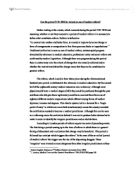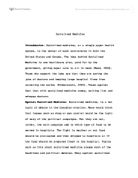History The renaissance
How far do you agree with the statement, 'The medical renaissance change some aspects of medicine but kept others the same'? The renaissance period did help the study of medicine quite a lot and showed just how much it was needed and how important it was in the study of medicine. By looking back at the dark ages and previous periods of time, we can tell what had changed and what has stayed the same. We can also tell what new discoveries had been made and if they were for better or for worse. During the dark ages and through past periods of time many discoveries were made. Some of these discoveries and theories carried on for many centuries but some were wrong. Discoveries were made such as; the brain controls the body which was found out from dissection. This helped with developments in human anatomy and the body. Also, the 4 humours theory which came across in previous years and it was the idea that the 4 liquids in your body had to be balanced to be well and if they were unbalanced, you were sick. This idea carried on for many years. The life expectancy rate was quite low which meant that improvements were still needed to be made to increase the life expectancy. Also, for many diseases and for the Black Death people believed that the causes were linked to miasma and the smell. For example; the Black Death in 1348. During this time, the people used to cauterize to heal
Can the period 1750-1850 be viewed as one of medical reform?
Can the period 1750-1850 be viewed as one of medical reform? Before looking at the events, which occurred during the period 1750-1850 and assessing, whether or not they amount to a period of medical reform it is necessary to define what constitutes reform. Reform is defined as: 'To convert into another and better form, to amend or improve by some change or form of arrangements or composition to free from previous faults or imperfections.'1 Traditionally this time is seen as one of medical reform, uninterrupted progress stimulated by advances in medical education, professional unity and social reform and confirmed by medical legislation. Although there was progress during this period there is controversy as to the extent of change that was actually achieved and to whether the motivations behind the change mean that they can be constituted as genuine reform. The reform, which is said to have taken place during the aforementioned hundred-year period, is attributed to the advances in medical education. By the second half of the eighteenth century medical education was in disarray. Although most physicians did have a medical degree (MD) they could be purchased through the post and those who did gain them legitimately could have received them from one of eighteen different medical corporations which offered varying forms of medical diplomas, licenses and degrees. This chaotic
Sex and Health in the Middle AgesSeveral centuries ago, in the population's mind, as well as for Jewish, and the Christians and/or Muslims, everything was about religion and God
Sex and health in the Middle Ages By Kaven Morasse Presented to Daniel Perreault For Intro: Western History 330-910-RE November 8th 2004 Sex and Health in the Middle Ages Several centuries ago, in the population's mind, as well as for Jewish, and the Christians and/or Muslims, everything was about religion and God. Because of this, these religious groups were fully confident about the evidence that was given to them by the "intellectuals". Supported by religion, these "scholars", even though they were inaccurate most of the time, had answers for almost everything. Since their objectivity was often affected by diverse beliefs, these savants' way of thinking became the pillars of these societies. In the Middle Ages, though medicine and reproduction were often thought to be of a religious matter directed by God, human involvement was usually acceptable (Wiesner, p.132). These subjects are good examples of what kind of fundaments were anchored in people's thoughts. Three sources, written by philosophers of the middle ages, have been studied to demonstrate what kind of misconceptions they had; the Canon Avicenna, Constantine the African's treatises and Trotula of Salerno's writings. The diverse traditions and religions truly affected the way people of the Middle Ages perceived reproduction. This is proven by the fact that in some civilizations reproduction was seen
Category - Simple Schizophrenia - appears during late adolescence.
Psychology Assignment ) Mental Illness - SCHIZOPHRENIA Category - Simple Schizophrenia - appears during late adolescence. Symptoms include increasing apathy, decline in academic or work performance and gradual social withdrawal. The sufferer may be regarded by others as idle, or a drifter. Diagnosis depends on establishing the gradual progression and worsening of these symptoms. Hallucinations and delusions are not usually manifest. I choose this mental illness because I want to become a children's nurse and I thought it would be a good idea to know about the mental aspect of children's illness. 2) Schizophrenia itself comes under DSM-IV but the sub-category simple schizophrenia comes under ICD-10; because it does not prescribe what exactly should be in the diagnosis; people with simple schizophrenia may manifest a variety of symptoms. These may vary from one individual to another. (There are no set symptoms for diagnosis). 3) Cognitive Theory - is about how we perceive and process information and how it affects our behavior. People with Simple Schizophrenia will have negative thoughts patterns, which will affect their behavior. They may probably have "set rules" for living which they have developed while growing up. These are based on what we learn from other people and our own experiences. They may be realistic or unrealistic, helpful or unhelpful. For example
How much progress did the Egyptians make in Medicine?
How much progress did the Egyptians make in Medicine? Helen Stanford Some people feel that the Egyptians made considerable progress in medicine because of the way they could examine parts of the body during the mummification process. This allowed them to find out information about how the body worked. By removing the organs, they knew where they were located inside the body and what they were attached to. The Egyptians discovered that the body could be preserved in many things, including salts, oils, and bitumen. Before electricity was discovered and fridges were made, people used salt to preserve food that needed to be kept cold, so we still use the Egyptian's technique thousands of years later. Other people think the Egyptians didn't make such great advances because of their theory about the river Nile and how it worked in conjunction to the human body. The Egyptians believed that the body was full of channels, just like the Nile was. If an irrigation channel was blocked on the Nile, the water would not flow into the fields - a disaster for Egyptians because they inhabited the area surrounding the Nile because of the fertile land it offered. The Egyptians believed the same thing happened with the human body - that the blockage of the vessels lead to the person becoming ill. Vomiting was encouraged in some patients, as it was thought to clear blockages from the
complementary therapies
complementary
What is known about how people perceive, take and communicate risks?
What is known about how people perceive, take and communicate risks? Logic dictates that the physical consequences of hazards are fixed objective. However perceptions of risks associated with those hazards are highly subjective and as a result risk has been defined in a number of ways. Risk can be viewed as the probability of undesired consequences, the seriousness of the maximum possible undesired consequences or the product of these two outcomes. Another definition of risk is the variances of all the consequences about their mean. In addition to research which aims to identify the factors which affect our perception of risk, studies have investigated the motives which affect our propensity to take risks as well as the best techniques for communicating those risks. Both lay person and expert assessment of risk involves human judgement. Expert judgement is likely to be more accurate but both groups are subject to common distortions of risk which tend to favour certain criteria which reflect our subjective perception of risk rather than the reality of it (Sprent, 1988). Sprent identified ten common distortions of risk. Two such distortions of risk are the notions that concentrated risks are worse than diffuse risks and involuntary risks are worse than voluntary risks. Slovic et al (1978) studied the common distortion of risk whereby concentrated risks are regarded as worse
Complementary Therapies.
Complementary Therapies. Task 1. Acupuncture- oriental therapy Acupuncture is the stimulation of the special points on the body, usually by inserting needles. Originating in the Far East about 2000 years ago, it has made various appearances in the western medicine. Acupuncture recent popularity in the west dates from the 1970s when president Nixon visited china. In its original form acupuncture was based on the principles of traditional Chinese medicine. According to these the workings of the human body are controlled by a force or energy called qi (pronounced chee"), which circulates the whole body between organs on channels called meridians. There are 12 main meridians in the body each of which correspond with a major function or organ in the body. Qi energy must flow in the correct strength and quality through each meridian for health to be maintained. The acupuncture points provide a means of altering the flow are positioned along the meridians the skill of acupuncture is knowing where and how to stimulate the skin and subcutaneous structures in order to achieve the desired result. The point may be stimulated with needles or alternatively an electrical current or by laser heat and massage. Treatment is usually painless although the patient may feel some dull heavy pain this is associated with a positive response relief mat be immediate or improvement may take
Case study-Myocarial infarction
NUR 364: Human Sciences in Nursing 2 Alice Pryce-Williams March 2007 Cohort Human Sciences in Nursing 2 This assignment is going to explore how biological, psychological and social factors of a person's life may impact upon their health status. This will be done by including a detailed patient profile of Jane, a 55 year old patient, who suffered a myocardial infarction (MI) and was nursed in an acute hospital setting. The altered physiology that occurred as a result of the MI will be looked at with consideration to psychosocial factors that may have contributed to the patient's illness. MI is one of the most common manifestations of CHD according to Todd (2008) and so Jane's main risk factors for the development of coronary heart disease (CHD) will be identified, with particular attention on the issue of smoking. How smoking may have contributed to the cause of an MI will then be explored, with an analysis of the factors that may have influenced Jane taking up smoking. The main factors that will be looked at will be how living in a low social economic household gives more chance of becoming a smoker, and how influences from family and peers may trigger smoking behaviour. Government interventions such as the smoking ban will then be looked at, and how National Service Frameworks (NSF) have been put in place to tackle the high numbers of CHD, as the disease accounts
Socialized Medicine.
Socialized Medicine Introduction: Socialized medicine, or a single payer health system, is the center of much controversy in both the United States and Canada. The idea behind Socialized Medicine is one healthcare plan, paid for by the government, giving equal care to all in need (Reed, 2000). Those who support the idea say that they are saving the jobs of doctors and keeping large hospital firms from cornering the market (Himmelstein, 2004). Those against feel that with socialized medicine comes, waiting list and unhappy doctors. Against Socialized Medicine: Socialized medicine, is a hot topic of debate in the Canadian election. Many would think that issues such as drug or gun control would be the topic of many of the political campaigns. But they are not, rather, the main campaign add is which type of food to be served in hospitals. The fight is weather or not food should be pre-cooked and then shipped to hospitals or if the food should be prepared fresh in the hospital. Topics such as this about socialized medicine plague much of the headlines and political debates. Many against socialized medicine, feel that much needed time and money is being wasted and should be spent on other, more beneficial, ideas. Another flaw with the socialized medicine campaign is waiting times. The average waiting time for a surgery in Canada is 13.3 weeks(reed, 2002). This is substantially











